How to choose an infrared carbon heater: overview of types and tips for buyers
Manufacturers offer a variety of carbon heating devices.Agree, the variety of equipment in appearance, power, cost and other characteristics can easily confuse an inexperienced buyer.
We will help you understand the range of offers. Before choosing a carbon heater, you need to understand the principle of its design and operation, as well as compare the operating features of different models.
The content of the article:
Carbon heating element design
The consumer’s desire to buy a heating device that does not dry out the air, warms well, and uses a minimum amount of energy is feasible. These requirements can be met by a carbon heater, which is one of types of infrared devices. It is based on a carbon heating element.
Carbon is the carbon from which the filaments that serve as the basis of the heater are made. They are twisted into a spiral placed in a vacuum tube made of tempered glass. The thickness of the spiral depends on the power of the device - the higher the power, the denser and longer the carbon thread will be.
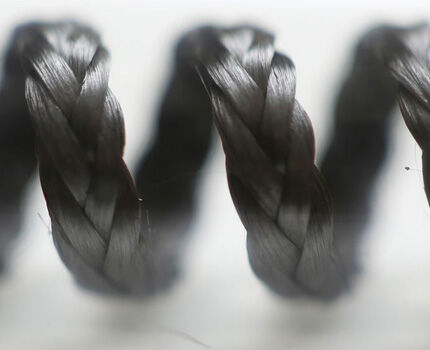
This type of heater is capable of producing infrared rays of 1800-2400 nanometers, while having a negative temperature coefficient.This means that as the temperature increases, it will need less electricity.
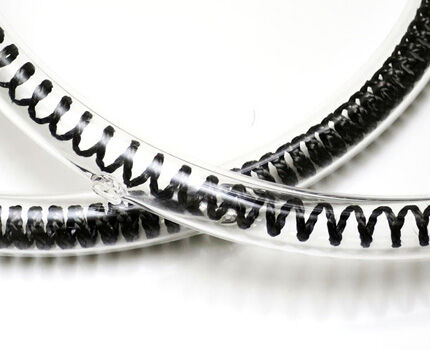
A carbon fiber spiral enclosed in a vacuum tube does not burn out when heated. This is a significant advantage over tungsten heating elements.
This feature allows you to use the heater for a long time, adhering to the rules of operation of a device containing a carbon filament.
Design and principle of operation of a carbon device
Devices that operate thanks to the heating of a carbon spiral differ in performance characteristics, appearance, and material of manufacture. What is common is the arrangement of the devices.
The base is a tube with carbon threads twisted into a spiral. This is a heating element. Depending on the power of the device and its model, there may be 2, 3 or more such tubes.
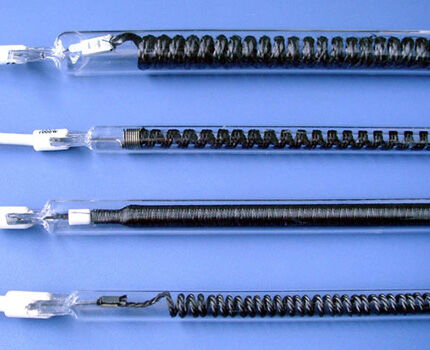
The carbon heater is housed in a housing with an anodized aluminum reflector. For safety reasons, the tube is fenced off from the outside world.
Depending on the model, the device may have a control panel, a stand with a rotation function, and a built-in temperature sensor, which is controlled using a rotary controller.
After the device is connected to the network, an electric current passes through the carbon threads, heating them. Long-wave infrared radiation occurs, freely penetrating through the glass.There is no harm from it, because “carbone” - “carbon” is essentially the same as coal.
The main feature of radiated heat is that it heats objects in the field of action. The air in contact with the device and objects begins to heat up from the objects that have received their portion of heat.
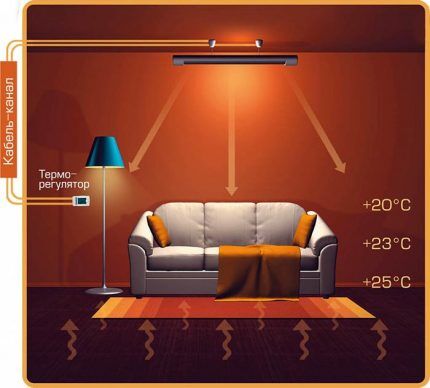
Infrared rays, hitting the surface of objects and the human body, warm up to a depth of 2.5 cm. Heating occurs on one side - from the heater.
The working area depends on the power of the device. On average, 100 W are capable of distributing heat over an area equal to 1 m2. But this indicator largely depends on the model of the device - some manufacturers guarantee a heating area of 20 m2 at a power of 900 W2.
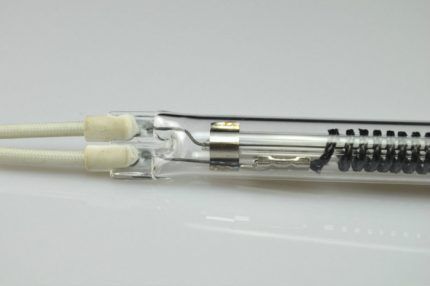
The heating element is the most reliable part of the device. The durable carbon strands that make up the carbon coil can last 100,000 hours or more.
The only problem is the vacuum quartz tube. Although tempered glass is used, the risk of damage is quite high. It is the glass that is considered the most vulnerable part of the device and the main disadvantage.
On the other hand, a plexus of hydrocarbon threads, securely sealed in a vacuum container, is protected from external influences - dust microparticles, water droplets, and accidental ingress of foreign objects.
Types of carbon heaters
Infrared carbon heaters come in a variety of shapes, dimensions, weight, power and cost. These characteristics are due to the characteristics of a particular model. The main criterion for classifying carbon devices is the method of installation or installation.
All heaters of this type can be divided into the following groups:
- wall;
- ceiling;
- floor
Flat ones can be divided into a separate group film type devices, also using carbon as a heating element. They can be mounted on a wall, ceiling or floor.
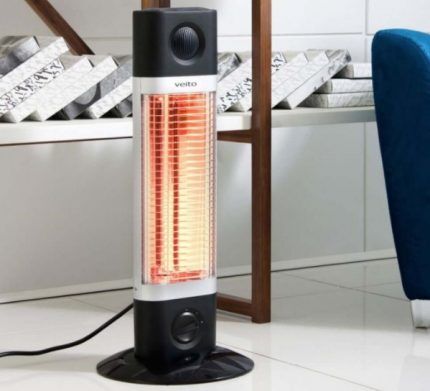
Each of these groups speaks for itself - their method of installation or installation is radically different. Their effectiveness and places of use directly depend on this.
Carbon-type heaters can be installed in an apartment, in a country house, in a private house, in a car, in the summer areas of cafes, in industrial premises with high ceilings, in the office.
If you place the heater outside, you should take into account that the heating area in this case will be 2-2.5 times smaller than inside the building.
Characteristics of wall-mounted devices
The main advantage of wall-mounted models of carbon heaters is saving living space. Due to the fact that the heater has special mounts for mounting on the wall, it can be placed even in a small apartment without harm to the residents.
After all, when every centimeter of the room is important, then a wall-mounted structure will be the most reasonable option for a heating device.
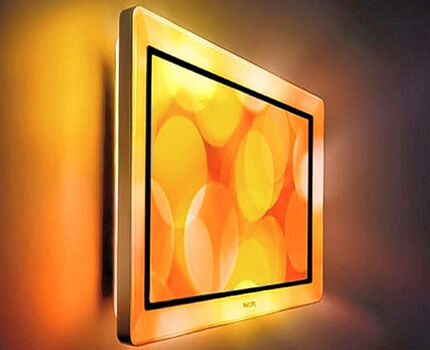
There are no special features in the design of the wall heater. You can install it yourself, without resorting to the services of specialists. The fastenings provided by the manufacturer are reliable. They are able to support a device that has such a small weight - up to 4 kg.
The cost of a wall-mounted model largely depends on the popularity of the manufacturer and its reputation in the market.
Also, the price is directly affected by the power of the device, the warranty period of service, additional functions and capabilities provided by the device developers.
To properly install a wall heater, you need to determine what items should be in its working area. It is advisable to mount the device so that it has a maximum viewing angle.
If you choose a bad place, you will have to re-weight it. For such models, it is important that the control panel is included.
The main disadvantage of wall-mounted carbon devices is the difficulty of maintenance - in order to wipe off the dust, you still need to get to it. The second is the higher cost compared to floor options.
This is due to the presence of mandatory functions for adjusting the temperature and operating power of the device via the control panel.
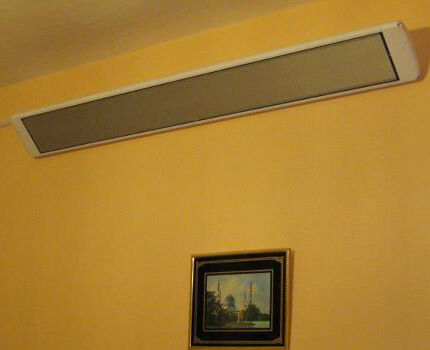
On the other hand, the installation location, located above the head, is considered by some consumers to be one of the advantages. Wall and ceiling models are in great demand among families with children. It is convenient that the device is out of reach of a child.
Ceiling carbon devices
Carbon heaters can be installed on the ceiling.Manufacturers offer various models that can be safely integrated into any interior without damaging it. There are options mounted into a suspended ceiling structure.
Before installing ceiling carbon heaters, it is important to correctly calculate the required power and select their installation locations. Such options are most often used for heating industrial premises with high ceilings. High-power models that have more than one heating element are suitable here.
Small devices of 800-2500 W are installed as additional heating equipment in country houses. This is very convenient - literally 10 seconds after turning it on, it starts working, warming chilled guests and the pieces of furniture on which they settled.

When using ceiling heaters, do not place objects, devices with plastic casings, or fabrics too close. Excessive heating of the plastic may cause an unpleasant odor.
A ceiling device equipped with a timer and thermostat is capable of maintaining a comfortable temperature setting once set by the user. Also, there are models that can remember several temperature options.

Carbon appliances do not dry out the air, because the heating element is not in direct contact with the air. Therefore, in rooms with such heaters you will not have to worry about additional humidification.
Features of floor heaters
The most common models of carbon heaters are floor-standing. They come in a variety of sizes and shapes - it all depends on the designer’s imagination. Their main advantage is mobility and light weight. Such a device can be loaded into a car and taken with you to the dacha.
Based on their appearance, floor heaters are divided into horizontal and vertical. Depending on their capabilities, there are stationary and rotary devices. The angle of rotation depends on individual characteristics - from 90° to 180°.
This feature appealed to a large number of buyers. Also, models with remote control are in particular demand, despite their higher cost.
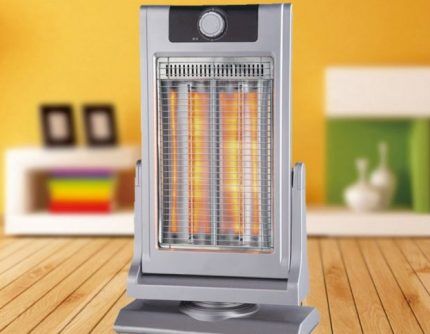
The ease of use of floor-standing appliances speaks for itself - you install it and you can turn it on. No installation required. The variety of shapes allows you to choose the best option for your home, harmoniously combined with the interior.
The carbon heater creates a special cozy atmosphere in the room, as if a fireplace was used for heating.

For safety reasons, floor-type carbon heaters are equipped with an automatic shut-off function. It is triggered when it heats up above the permissible temperature or when the device overturns. If the owner accidentally drops a working heater, an automatic relay will turn off the device.
To maintain a comfortable temperature without human intervention, you can use a thermostat for socket.
Flat or film type systems
One of the varieties of carbon heaters can be called film-type devices that operate on the basis of carbon fibers laid parallel to each other. You can install such films yourself.
To do this, you will need to carefully calculate the required heating area, carefully cut the film without damaging the strips with the heating element.
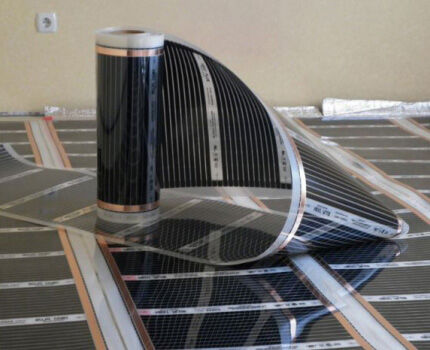
At installation of infrared film It is important that the segments do not overlap each other. Furniture cannot be placed in their locations. This insulation system copes well with the function of heating a loggia or a separate area of the room.
The efficiency of the devices is quite high - because the generated heat is not wasted, it is directed to objects.
Carbon heating films can be installed on the ceiling, wall or floor. Manufacturers offer improved versions of film-type devices, designed in the form of paintings. Decorative finishing is applied to the plasterboard frame. The main condition is that this design should not contain metal parts.
Is it possible to build such a heater yourself?
A homemade device operating on the principle of a carbon film can be built on your own from scrap materials.When performing such work, it is important to thoroughly dry all workpieces, check the power so that it can be safely connected to the network and pay special attention to insulation.
According to the craftsmen, a heater assembled with their own hands is not inferior in performance to purchased analogues.
To make it you will need:
- epoxy adhesive;
- copper terminals;
- wire with plug for connecting to the network;
- graphite powder;
- 2 sheets of laminated paper.
To obtain a graphite conductor, you need to mix epoxy glue with graphite powder. Stir the mixture thoroughly - it will serve as a heating element.
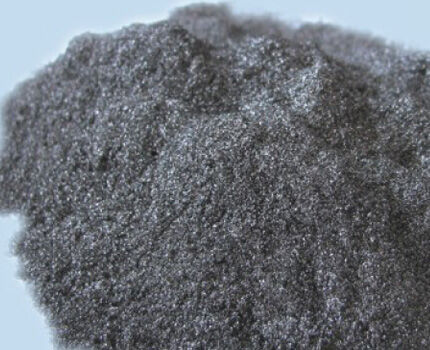
The resulting conductor must be applied in a zigzag pattern to the prepared sheet. Then you need to glue the sheets of plastic together with glue, attaching copper terminals to the conductor on different sides.
You can also connect a thermostat, which will help regulate the temperature after the heater is assembled.
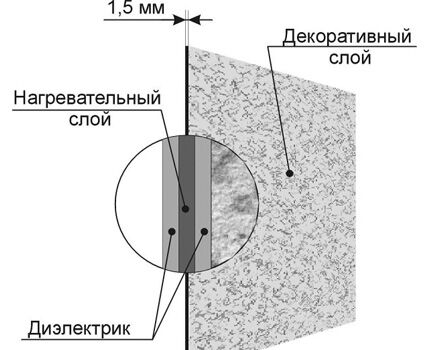
Having carefully fastened everything, you have to leave the workpiece to dry completely. All contacts, wires and parts carrying current should be properly insulated. After drying, be sure to measure the resistance of the device and calculate its power. Without these tests, it is strictly forbidden to connect the device to the network.
Tips for choosing a carbon heater
Carbon heater is one of the safe devices capable of long service life. Of course, if used correctly.
It does not burn oxygen, does not reduce the level of humidity in the room, is safe for children, and does not emit any harmful gases, vapors, or toxic substances.
The safety of carbon heaters has been proven by their successful use since the beginning of 2000. More than 15 years of practical use of devices with a carbon heating element prove that they do not cause harm to health. More information about myths regarding infrared emitters is written in this article.
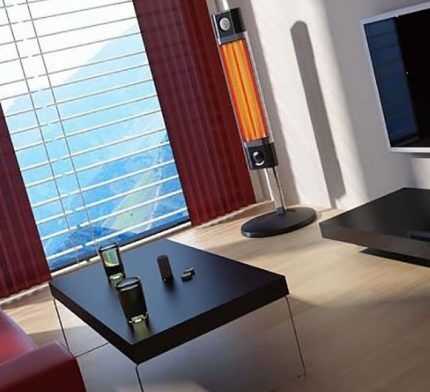
In order for the use of carbon heaters to bring only positive emotions, you need to choose the right model that is suitable for a specific consumer.
When choosing, it is important to consider a number of features:
- where the device will be used - in a country house, in an apartment, office or other type of premises;
- the area to be heated;
- what type of device is most suitable in a particular situation;
- required power;
- availability of additional functions and capabilities;
- the size of the budget allocated for the purchase.
For buyers who value the fame and reputation of the equipment manufacturer, the cost will be slightly higher - they will have to pay extra for the brand.
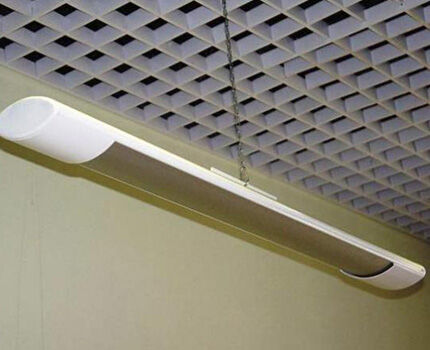
Among manufacturers of carbon heaters, the following devices are most popular:
- German models Zenet;
- French Noirot Royat;
- Turkish UFO, Maximus, Sinbo;
- Chinese Polaris;
- Russian BiLux.
The power of the devices, their design and heated area depend on the model and manufacturer. Also, the warranty period for heaters ranges from 12 months to 6 years. It all depends on the manufacturer.
Devices of different brands with the same power can cope with heating of different areas. This fact should be taken into account when choosing a suitable model, and carefully study the accompanying documentation of the model you like.
As for price, traditionally the cheapest options are offered by Chinese companies. There are many of them and most of them are not of high quality. Therefore, buyers prefer to purchase devices from well-known manufacturers.
One of the reliable brands of heaters produced in the Middle Kingdom are devices Polaris. They are trusted among buyers.
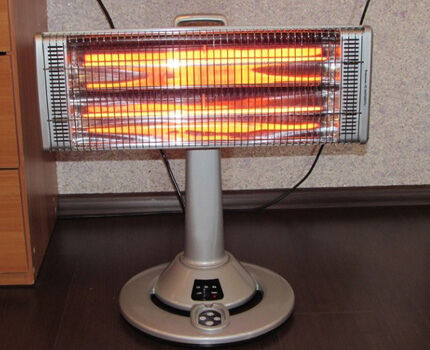
Which company to choose is a personal matter for each buyer. The main thing is that the heater meets all the requirements for it.
The most popular models are those controlled by remote control, equipped with a rotating mechanism and a timer. Users prefer comfort, even if they have to pay a little extra for it.
Interestingly, many buyers of carbon heaters talk about the beneficial effects of infrared rays generated during operation. This concerns improving blood circulation, easing the occurrence of colds and joint diseases. It is important to use the heater correctly so as not to harm yourself.
If you have not yet decided on the choice of a home heater, then read the article - Which heater is better to choose for a house and apartment: a comparative review of units
Conclusions and useful video on the topic
Video instructions for using a carbon heating device:
Video about installing infrared film:
Carbon heaters emitting infrared rays are capable of efficiently warming furniture and people in the operating area. They use electrical energy very economically, transfer heat to surrounding objects as much as possible, without wasting it on heating the air.
The service life of the carbon heating element is more than 100,000 hours of high-quality operation.The main thing is to choose the right model, taking into account the characteristics of your room and personal preferences.
Looking for an efficient infrared heater? Or do you have experience using carbon installations? Please leave comments on the article and share your impressions of the operation of such heaters.




I have a carbon fiber heater installed in my garage. I can’t say that I’m delighted with this method of heating a room. The heat transfer from it is insignificant. Warmth is felt only under the rays, in the “shadow” it is cold. Glass tubes are quite fragile. Moving the heater from place to place is dangerous; it may crack. The only plus is efficiency. Consumes less energy than others.
I agree with Alexander - this is not the best option for heating. From personal experience. We bought this heater for our home last year. We didn’t think much about it right away, we bought it on a short stand. The heater itself is very hot, so this option should be discarded immediately in a house with small children. I also see little point in using a ceiling device: hot air rises anyway, why heat it further. The lower the heat source, the more correct the convection. However, if you point it directly at yourself, it warms very pleasantly.
You didn't read the article carefully.
The heater does not heat the air. It heats up the object. If it is ceiling-mounted, it heats the floor, and the heat from the floor rises. If it is a standing option, then it also rotates and heats the walls and bed. Having turned on the heater at half-heat, it’s a pleasure to fall asleep, the light is like from a fireplace.If you have small children, then, excuse me, what does this heater have to do with it. All heaters are hot, if you share information, share it correctly.
Is such a heater suitable as an additional heat source for a specific small room? There are no radiators there and when it gets cold outside, it becomes cool inside, unlike the rest of the house. Specifically, I am interested in whether the heater can cope with a room 4 by 2.5 m.
What kind of infrared carbon heater are we talking about, what model are you interested in: wall-mounted, floor-mounted or ceiling-mounted?
The room is small, but the height of the ceilings also needs to be taken into account in order to choose the most suitable heater model. For a room of your size, I advise you to choose a 900-watt infrared heater with a heating area of 18 m2. This is with a reserve, since I don’t know what kind of room it is, what kind of thermal insulation the room has, or whether it has any at all.
There are heaters with wall and floor installation types at the same time. Choose a heater that has a ratio of infrared heat of 50% and convection of 50%. This is the best option for heating both residential and commercial premises.